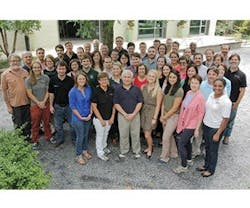How Challenge Winners Slashed Energy and Water Use
From behavioral changes to strategic equipment investments, the 125 teams participating in the 2015 Battle of the Buildings raced to shed excess energy and water use. The results are in, and though many competitors earned the prize of improved energy and water performance, two organizations have emerged victorious with the largest confirmed savings using off-the-shelf technology and smart management strategies.
The Texas A&M ESCO Project team took home the gold for energy savings by improving energy efficiency by 35.5%, saving more than $548,900 over the year-long competition. The team focused on the six buildings with the highest energy consumption and greatest room for improvement across the 20 million-square-foot campus, where they completed full lighting retrofits and installed pump VFDs.
The most important project involved installing lighting occupancy sensors and connecting them to an upgraded direct digital control BAS (which replaced an older pneumatic version). The lighting sensors also controlled the HVAC system to maximize savings in both.
On the behavioral front, Texas A&M’s Utilities & Energy Services department appointed a full-time team to work with the occupants of each building to maintain comfort while conserving as much energy as possible. They recruited occupants to follow campus temperature standards and help the department raise awareness of sustainable practices, allowing the customers, utilities department, and BAS technician to collectively make decisions that met everyone’s objectives.
A separate Texas A&M project focusing just on the residence halls also took home honors in the competition, landing a fourth-place finish with a 21.8% reduction in energy that yielded roughly $363,700 in cost savings.
Led by coaches at the Southface Energy Institute, the Boys & Girls Clubs All Stars, a team of Boys & Girls Club organizations from multiple locations, shed a stunning 50.2% of their water use, saving roughly $15,900. They also achieved second place in team energy reduction by slashing their energy use by 30.6%, which yielded another estimated $86,500 in savings. The clubs started with LED lighting and occupancy control retrofits, highly visible projects that improved lighting quality, saved money and increased interest.
Building on this momentum, the Southface team implemented Web-based thermostats with integral occupancy sensors and trending capabilities that allowed the coaches to give each club feedback on how to optimize their HVAC systems. This helped each location minimize the amount of energy wasted when buildings were unoccupied while maintaining optimal comfort when guests were in the building. Club directors could also easily adjust the temperature as needed throughout.
The biggest water savings came from eliminating water leaks and replacing older plumbing fixtures with new, efficient models. Secure faucets and low-flow versions of toilets and urinals significantly reduced water waste.
In addition, the whole team used Portfolio Manager to both track energy and water use and compare consumption across buildings, making it easy to determine where to focus savings efforts. Comparing water consumption rates helped the team identify several leaks.
